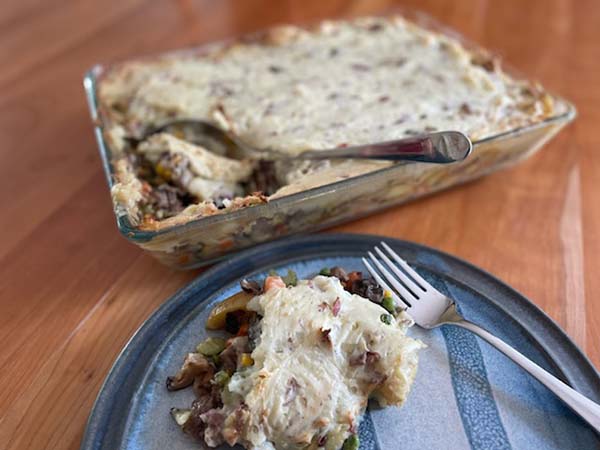Thaw Out Healthy Meals During Cold (and COVID) Weather

During these dark days of winter, I have been thinking a lot about thawing. Not the snow on my roof or the ice on my car windows but thawing some of the food I have stocked up in my freezer.
Especially now, if I can use what I have frozen, then I can stay home more, save money, and enjoy healthier meals, which are lower in sodium than those I would get if I ordered out. These are all wins for me.
Think about stocking up your freezer if you’re not in the habit. I buy foods when they are on sale and then stock up for meals later. March is Frozen Food Month, so keep an eye out for good buys.
When you think about frozen foods, don’t think pizza, TV dinners, or veggies swimming in a salty sauce. Instead, think berries, simple veggies, homemade broths, and seasonings. Think frozen soups, stews and chilis.
Storage tip: If your freezer is too full, try using a lightweight cardboard box like a cereal or cracker box. Cut the side or top off and use them to slide bags of frozen veggies or berries into. Boxes will stack much easier, and let you use all or your freezer space. I use square freezer containers for the same reason; they take up less room, and I maximize my storage capacity.
What to keep in your freezer and ideas on how to use these items:
- Homemade chicken broth: Lower in sodium than regular broth, and much tastier. Use in soups, stews, gravies, and casseroles.
- Frozen paneer: This Indian cheese freezes great and is low in sodium. Add it right into curries or curried vegetable dishes like Sag Paneer (paneer with leafy greens such as frozen spinach).
- Frozen rice: If I cook too much rice, I freeze it. Then I can use it weeks later in stir fried rice, or even rice pudding (just add eggs and milk).
- Frozen yakisoba noodles: Keep a bag or two in the freezer for winter stir-fries or soups. Add leftover veggies and/or leftover meat, and a wonderful dinner is ready in minutes.
- Frozen veggies: Keep frozen edamame or sugar peas; try with Yakisoba noodles. Add frozen mixed vegetables to the shepherd’s pie recipe below. Pour them into soups made with your chicken broth. Use frozen spinach in veggie lasagna. Add frozen corn to a bean-based chili, stir-fried rice, or chowder.
- Frozen flavorings: Freeze some fresh ginger root—it lasts a long time and is easier to grate when frozen. Grate the peel off lemons, oranges, or limes and freeze it in small zip lock bags. Sprinkle the zest in with a dollop of honey in fruit salad. Add grated lemon or orange rind to homemade scones or biscuits for flavor without salt. Freeze garden herbs such as cilantro root. Frozen herbs have more flavor than dried ones.
- Frozen pesto: Make salt-free pesto in late summer and freeze in small containers. Add to pasta, top a homemade pizza, or stir it into rice or soups.
- Frozen berries: So flavorful! Sprinkle frozen berries on yogurt. Add to oatmeal or homemade granola. Use for smoothies or add a few handfuls to a homemade apple cobbler. Heat with a bit of sugar and use to top ice cream. If you have a ton of berries, make freezer jam or easy microwave jam.
- Frozen shrimp: A small bag of frozen shrimp is one of my favorite treats. Add a handful to stir-fries, soups, or chowders.
- Frozen ground beef: When ground beef is on sale, buy a family-sized portion. Pan fry with lots of onion, drain the fat off, and then freeze in one-pound containers. It’s even easy to thaw. Drop right into a pot of hot chili, or add with frozen veggies for shepherd’s pie.
Shepherd’s Pie
- 1 pound of ground beef or turkey, leftover beef (chopped fine) or frozen, pre-cooked ground beef with onions
- 1 tablespoon oil
- 1 cup onions, diced (omit if using pre-cooked ground beef with onion mix)
- 2 cups mushrooms, chopped
- 3–5 small new potatoes, cut into 1-inch wedges
- ¼ cup unsalted butter
- ¼ cup flour
- 2 cups milk or rice milk
- 1 bag frozen mixed vegetables, 3 cups
- 2 tablespoons fresh, frozen, or dried parsley, chopped
- ½ teaspoon black pepper
- 1 tablespoon fresh or 1 teaspoon frozen or dried sage
- 2 cups instant or homemade mashed potatoes
In large skillet, add oil and ground beef or turkey. Cook until brown. (If using pre-cooked ground beef and onions, skip this first step and add mushrooms to the pre-cooked mixture.) Add onions and mushrooms. Cook until onions are transparent. In a small bowl, microwave potato wedges for 5 minutes, or boil in water on stovetop until tender.
In a saucepan, melt the butter, add flour, and cook over medium heat until light golden color. Slowly add milk, stirring until thick and creamy. In a 9″x13″ baking dish, combine beef mixture, potato wedges, vegetables, parsley, pepper, sage, and sauce together. Spread evenly in dish. Make homemade mashed potatoes or instant potatoes according to package directions. Spread mashed potatoes on top. Bake at 350 degrees for 30 minutes. Makes 6 servings.
Nutritional information (per serving using rice milk)
Calories 393, Carbohydrates 35 grams, Protein 19 grams, Sodium 187 milligrams
 Contributor Katy G. Wilkens recently retired as registered dietitian and department head at Northwest Kidney Centers. The National Kidney Foundation Council on Renal Nutrition has honored her with its highest awards for excellence in education and for significant contributions in renal nutrition. She has also been awarded the Medal of Excellence in kidney nutrition from the American Association of Kidney Patients.
Contributor Katy G. Wilkens recently retired as registered dietitian and department head at Northwest Kidney Centers. The National Kidney Foundation Council on Renal Nutrition has honored her with its highest awards for excellence in education and for significant contributions in renal nutrition. She has also been awarded the Medal of Excellence in kidney nutrition from the American Association of Kidney Patients.
Photo at top: Shepherd’s pie made with a mix of frozen veggies and frozen ground beef. Photo by Katy G. Wilkens.
Eating Well, Living Well classes
Studies show that working with a registered dietitian can delay kidney failure and postpone dialysis for longer than two years. FREE nutrition classes taught by Katy’s former team of registered dietitians at Northwest Kidney Centers are available at convenient times and locations around Puget Sound. Eating Well, Living Well classes teach people how to eat healthier to slow the progress of kidney disease and postpone dialysis. Learn more at www.nwkidney.org/classes.
![AgeWise King County [logo]](https://www.agewisekingcounty.org/wp-content/themes/agewisekingcounty/images/logo.png)